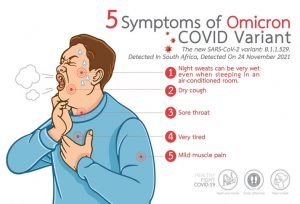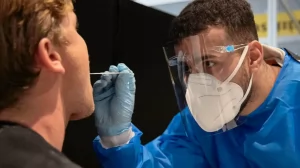The list of symptoms associated with COVID-19 is long, spanning everything from lost taste and smell to skin conditions. But since the pandemic began, health authorities have emphasized a few hallmark signs, namely coughing and fever.
As people the world over are finding, though, cases related to the Omicron variant don’t always produce those symptoms. During the Omicron wave, many people are reporting symptoms more in line with a common cold, with some puzzling additions—like lower back pain.
What are the most common Omicron symptoms?

Reports have varied. But overall, “this Omicron variant is acting more like a normal coronavirus,” such as those that cause the common cold, says Dr. Stephanie Sterling, an infectious diseases physician at NYU Langone Health.
“The classic symptoms of fever, cough and loss of smell were slightly less frequent with Delta than with Alpha, and the cold-like symptoms…became more common,” Spector says. “Omicron has really just increased that rather subtle change.”
Other research has come to slightly different conclusions. South Africa’s largest health insurer listed nasal congestion, sore or scratchy throat, dry cough and lower back pain as common Omicron symptoms. And a small study from Norway found that, among people in one case cluster, a cough was the most common symptom associated with the variant, followed by runny nose and fatigue. Like ZOE, the Norwegian researchers also observed a significant decrease in smell and taste loss.
Clearly, symptoms can vary from person to person, so people shouldn’t assume they’re COVID-free just because they don’t have classic symptoms like cough and fever. At least in areas where Omicron is prevalent, Sterling says, “the second you get respiratory illness, you have to presume it’s Omicron.”
Are most people experiencing mild symptoms from Omicron?
A mild case of COVID-19 can still make you feel quite sick and potentially lead to lasting complications like Long COVID. More research is needed to determine how often this happens. It’s also not entirely clear whether Omicron is itself milder, or whether population-level immunity from vaccinations. Because previous exposures is mitigating some of its worst outcomes.
How can I tell if I’m infected with Omicron or another variant?
When you take most standard COVID-19 tests, you’ll only get a positive or negative result; if you’re infect, it won’t tell you which strain is the culprit. You may never know unless health authorities send your sample out for genetic sequencing (and share the results with you). Symptoms offer clues, but even two people exposed to the virus at the same time could feel differently.
If you’re sick enough to need hospitalization, doctors might want to know which strain infected you, because certain therapies don’t work as well against Omicron as other versions of COVID-19, Sterling says. But if you have a mild case, don’t spend too much energy trying to figure out which variant you caught. You’ll need to rest and isolate yourself from others until symptoms subside, no matter what.












